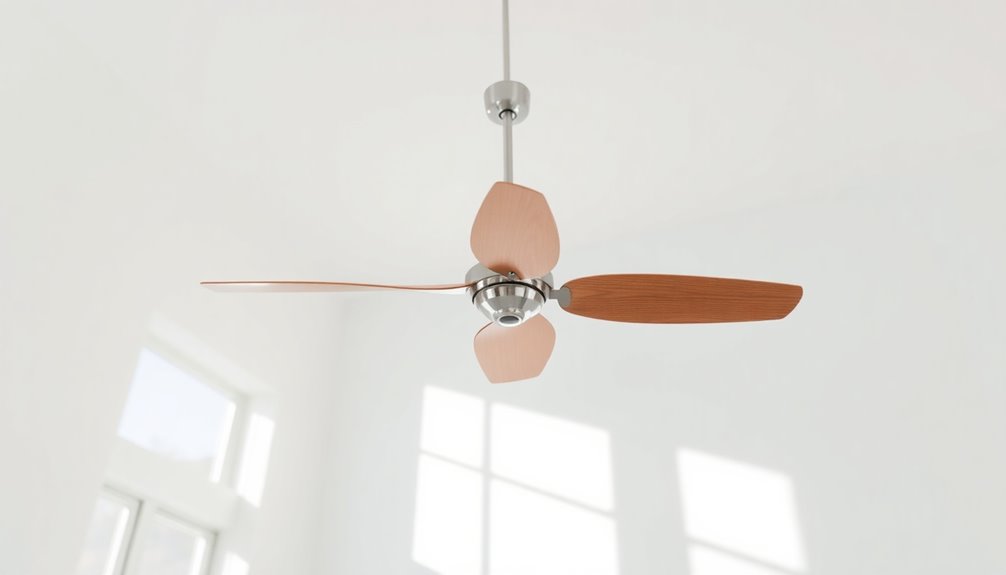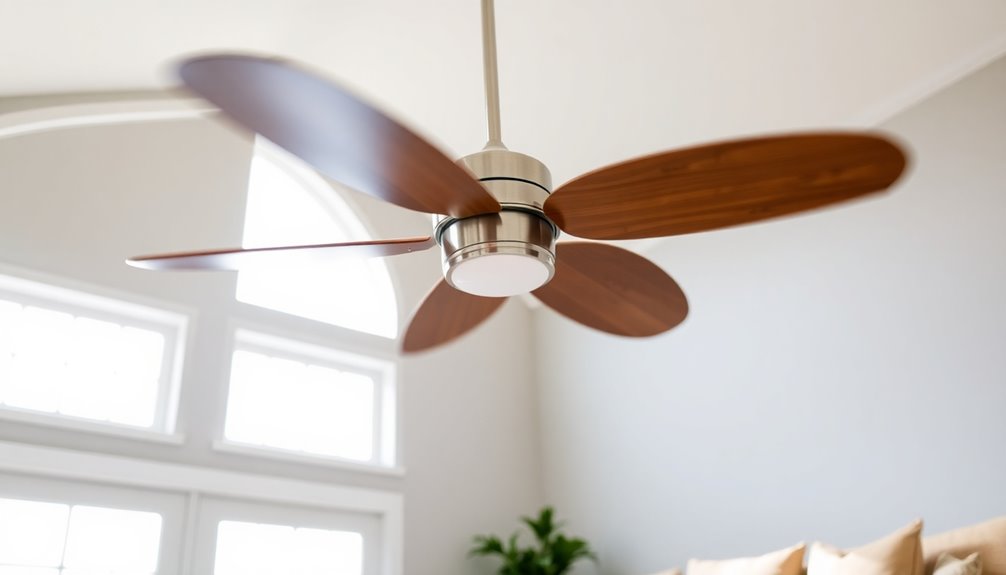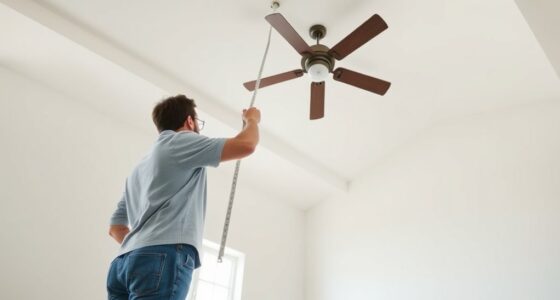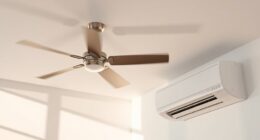Your ceiling fan should turn counterclockwise during summer to create a cooling breeze, helping you stay comfortable while potentially allowing you to raise your thermostat by a few degrees. In winter, switch it to clockwise to circulate warm air that collects near the ceiling, which can help reduce heating costs. Remember to adjust the fan's direction during Daylight Savings Time for ideal seasonal efficiency. Always turn off the fan before changing its direction, and do regular maintenance to keep it running well. Keep going to discover more tips on how to get the best from your ceiling fan!
Key Takeaways
- In summer, ceiling fans should rotate counterclockwise to create a cooling downdraft.
- In winter, fans should rotate clockwise to circulate warm air from the ceiling.
- Adjust fan direction during Daylight Savings Time for seasonal efficiency changes.
- Always turn off the fan before changing its direction for safety.
- Regularly check and maintain fan settings to improve comfort and reduce energy bills.
Importance of Ceiling Fan Direction

Understanding the importance of ceiling fan direction can greatly enhance your home's comfort and energy efficiency.
During the summer months, setting your ceiling fan to rotate counterclockwise creates a cooling downdraft, producing a wind chill effect that makes rooms feel cooler. This allows you to raise your thermostat by up to 4 degrees, ultimately lowering your energy costs.
In winter, it's vital to change the direction of your fan to clockwise. This adjustment circulates warm air that naturally rises to the ceiling, helping to warm your home more effectively. By doing so, you can potentially reduce heating costs by 15% or more.
Proper air movement is critical for maintaining a comfortable environment, and misalignment in ceiling fan direction can lead to inadequate airflow.
This inefficiency can result in discomfort and increased energy bills due to overworked heating or cooling systems. By understanding how to adjust your ceiling fan direction seasonally, you can greatly improve your home's climate control, ensuring comfort and cost savings year-round.
Seasonal Fan Direction Guidelines

Changing your ceiling fan direction seasonally can greatly enhance your home's comfort and efficiency.
In summer mode, set your ceiling fan to rotate counterclockwise. This creates a cooling downdraft, which produces a pleasant wind chill effect that makes you feel cooler without lowering the thermostat.
Switching to winter mode means adjusting the fan direction switch to clockwise. This gentle updraft redistributes warm air from the ceiling to the floor, helping maintain an even temperature throughout the room.
By following these seasonal fan direction guidelines, you can considerably improve energy efficiency. Proper fan direction can reduce energy consumption by up to 30% in summer and 15% in winter, allowing you to save on heating and cooling costs.
A simple way to remember when to switch is during Daylight Savings Time: change your ceiling fan to counterclockwise in spring for summer cooling and clockwise in fall for winter warmth.
With these adjustments, you'll enjoy a more comfortable home year-round while also being mindful of your energy usage.
Changing Ceiling Fan Direction

When it's time to adjust your ceiling fan for the new season, knowing how to change the direction is key to maximizing comfort and energy efficiency.
To start, turn off the fan and let it come to a complete stop for safety. If you have a pull chain fan, locate the ceiling fan direction switch, usually on the fan's body, and toggle it to switch directions. High-end brands often feature this direction switch for enhanced functionality.
For remote-controlled fans, confirm your remote is paired, then turn off the fan and hold the fan button to activate the reverse option; a blinking light on the remote indicates it's working.
Smart fans are even easier, as you can adjust them through compatible apps or voice commands using SIMPLEconnect® WiFi® technology.
After making the change, turn your fan back on and observe the airflow. If you've set it to turn counterclockwise, it should create a cooling downdraft to help regulate the temperature in summer.
Alternatively, set it to spin clockwise to generate a warming updraft in winter. This simple adjustment can greatly enhance your comfort and energy efficiency throughout the year. Additionally, understanding the benefits of choosing the best heat pump can further optimize your home's climate control.
Timing for Direction Change

Seasonal changes are the perfect cue for adjusting your ceiling fan's direction. A great time to make this change is during Daylight Savings Time, which happens twice a year.
When springing forward in March, set your fan to rotate counterclockwise. This direction helps create a cooling breeze, keeping you comfortable during the summer months.
Conversely, when falling back in November, switch your ceiling fan to rotate clockwise. This adjustment promotes warmth by circulating the heated air trapped near the ceiling, enhancing your comfort levels during winter.
To maximize the benefits of changing your ceiling fan direction, verify that it's appropriately sized for the room. A well-sized fan can considerably improve both energy consumption and comfort levels throughout the year.
Regularly adjusting your fan according to the season not only helps maintain a pleasant indoor environment but also aids in reducing your energy bills.
Ceiling Fan Direction Tips

Adjusting your ceiling fan's direction can greatly enhance your comfort and energy efficiency throughout the year. Here are some essential tips to help you improve your ceiling fan direction:
- Summer Settings: In summer, set your fan to spin counterclockwise. This creates a cool breeze that helps keep your spaces comfortable and can reduce air conditioning costs by up to 30%.
- Winter Settings: During winter, turn your ceiling fan to rotate clockwise at a low speed. This pushes warm air down from the ceiling, maintaining an even room temperature and potentially lowering heating bills by 15% or more.
- Change the Ceiling Fan Direction: Always turn off the fan completely before changing the direction using the reversing switch or remote control.
- Regular Maintenance: Regularly check your fan direction with the change of seasons, ideally during Daylight Savings Time, to guarantee maximum cooling and heating efficiency.
Frequently Asked Questions
How Do You Tell if Your Ceiling Fan Is Going Clockwise or Counterclockwise?
To tell if your ceiling fan's going clockwise or counterclockwise, stand directly beneath it and observe the blade movement.
If you feel a cooling breeze, it's spinning counterclockwise, perfect for summer. If there's no significant breeze, it's likely going clockwise, which circulates warm air downwards for winter.
You can also check the pull chain or remote settings to confirm the direction. If unsure, safely switch it off and adjust the toggle switch.
Which Way Should a Ceiling Fan Turn in the Summer?
In the summer, you want your ceiling fan to turn counterclockwise. This direction creates a cooling downdraft that enhances the wind chill effect, making your space feel cooler.
You can raise your thermostat setting by up to 4 degrees without sacrificing comfort, potentially saving you up to 30% on energy costs.
To check if it's set correctly, stand underneath and feel for that invigorating breeze. Keep it on medium to high speed for the best results.
How Do I Know if My Ceiling Fan Is in Winter Mode?
Imagine you're cozying up with a blanket, but you can't seem to shake the chill.
To check if your ceiling fan's in winter mode, look up at the blades. If they're spinning clockwise, you're good! You shouldn't feel a strong breeze beneath it; if you do, it's likely not set right.
Also, make sure the fan's running on low speed to circulate warm air evenly without creating drafts.
Which Way Is the Switch Supposed to Be on a Ceiling Fan?
You should check the switch on your ceiling fan to verify it's set correctly for the season.
In summer, it needs to be in the counterclockwise position to create a revitalizing downdraft.
When winter arrives, flip it to clockwise to push warm air down from the ceiling.
Don't forget to turn off the fan and let it stop completely before changing the switch to avoid any damage.
Conclusion
In the grand dance of comfort, adjusting your ceiling fan's direction can be a game-changer. By embracing the seasonal shifts, you can keep your space cozy in winter and invigorating in summer, just like nature intended. So, when the leaves turn or the sun blazes, don't forget to switch it up! With a simple flick of the switch, you're not just cooling or warming your room; you're orchestrating your very own symphony of comfort.









